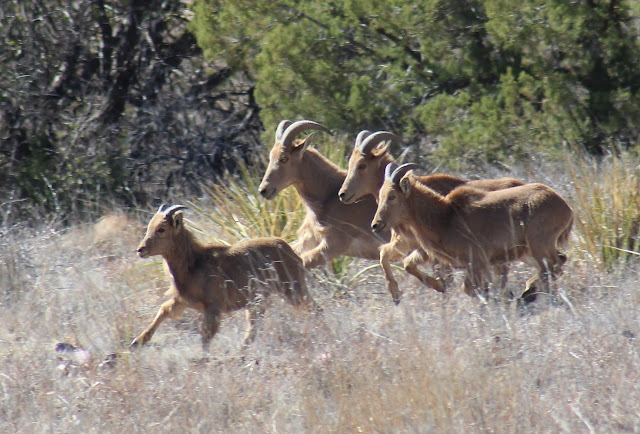Clear and
30°, with a sheet of ice in the parking lot next to the Subaru. I ate some yogurt and cereal for breakfast,
finished off the last of the fried chicken, and headed for Alpine to take care
of some town errands. They being
completed, I drove back to the Chihuahuan Desert Research Institute visitors’
center. They charge $6 entrance fee for
visitors to walk the trails, and the funds go toward maintaining the trails,
the native plants garden, and the bird feeders at the observation blind.
 |
| Chihuahuan Desert Research Institute |
It was
around 50° F when I started the loop trail, described as a “strenuous hike that
includes the Modesta Canyon, Lion’s Head Hill, a spectacular view of a ryholite
quarry and Clayton’s Overlook.”
The moderate
hike starts out across 1/4 mile of grasslands, with native grasses and cactus.
A 200-foot
descent into a narrow canyon with extrusive igneous rock on one wall of the
canyon and intrusive igneous rock on the other.
 |
| Tree Cholla (pronounced: "Choy'-ya") |
At the bottom of the canyon are Texas Madrone trees,
 |
| Texas madroño - Arbutus xalapensis |
and a natural spring feeding into a couple of small pools which host a fragile ecosystem of tree frogs, salamanders and crayfish.
 |
| Desert Oasis |
The trail continues to Lion’s Head Hill, returning to the Powell Visitor Center along the upper rim of the Canyon.
Native to northern Africa, aoudad - or
Barbary sheep - were introduced as exotic game animals into Texas back in the 1950s.
In the desert-mountains of the
Trans-Pecos, they’ve found a land in which they can flourish. Watching aoudad
storm down the rocky slope, it’s hard not to admire these hardy newcomers. But as their populations swell, these exotic non-natives appear
to be edging out native species - mule deer, pronghorn, and the native bighorn
sheep.
 |
| Aoudad |
The junipers
here were encumbered with mistletoe.
Continuing
to wander along the trail led me past this tree:
How odd! It
looks like it has two different colors of foliage. And the darker foliage seems
to form very distinct clumps. That’s
weird enough to warrant a second glance.
A second glance reveals that those dark clumps aren’t part of this poor
juniper tree – they’re mistletoe!
 |
| Mistletoe, probably Phoradendron juniperinum, in an alligator juniper tree |
The mistletoe growing in this juniper isn’t
the mistletoe traditionally associated with Christmas, Viscum album. But like
Viscum album, Phoradendron juniperinum is a hemiparasite in the sandalwood
family. Hemiparasites aren’t totally dependent on their hosts. While these mistletoes get water and nutrients
from their hosts, they can make their own sugars.
Just a note to watch the trail for the dreaded ankle-biter cholla . . .
At the
viewpoint on Clayton’s Summit, there is a Geology display.
 |
| A cholla at ankle height along the trail. Guess how I found this one? |
From here, there is a grand view of the Davis
Mountains - with interpretive signage!
 |
| I'll let you read these on your own . . . |
 |
| The real thing . . . |
 |
| Bah-ree'-yohs |
Mitre Peak
Musquiz Dome
Purertacitas
Mountains
Grasslands
 |
| A fire came through here in 2011 |
Mountains and Plains
Star
Mountain
Back down
the trail to the Visitors’ Center, I went over to their Botanical Garden, where
- amongst the usual cactus and flowering plants - they had a native grasses
display.
 |
| Most botanical displays ignore grasses . . . |
Since my wife, Marty, is the
Grass Queen of Western Washington, I enjoy seeing an outfit that takes pride in
its Gramineae!
Yes, I used “Gramineae”,
rather than “Poaceae”, which is how I learned it back in the previous Millennium. The taxonomists have changed the Family name
to Poaceae, to conform to the International Code of Botanical Nomenclature
guidelines. Plant family names are
usually made by taking the stem of the name of the "type" genus and
adding '-aceae', the standard ending that indicates family names. In this case,
the genus is Poa. The stem is 'Po-', add the standard ending and
you get Poaceae. However, a few of the
larger, well-known families had traditional names that were based on a quality
they possessed. Gramineae is taken from
the Latin word for grass "gramen" (stem gramin-) plus an ending '-eae'.
The rules for naming plants gives both
forms equal validity in these well-known families.
 |
| Bull Grass - Muhlenbergia emersleyi |
I stopped at
the bird feeders to take in some of the birds before leaving.
 |
| Not quite certain who was watching whom . . . |
On the way
south, I passed by a historical display for the Musquiz homestead.
It is
apparent that the Texans of the 1930s considered the extermination of the local
Native Americans as a virtue . . .
 |
| Adobe melts if it's not protected from the weathe |
As I was
driving south on Highway 18, I saw a small group of animals in the
mesquite. When I put my binoculars on
them, I was somewhat surprised to see that they were Scimitar-horned Oryx.
 |
| Oryx dammah |
This is a species of the African Sahel, and
was declared extinct in the wild since 2000.
There are a number of re-introductions in North Africa. However, the largest population of between
6,000 and 10,000 of these animals is in west Texas, due to hunter-driven
conservation efforts.
I got into
the Terlingua Ranch ‘resort’ a little after 5 p.m., and the office was closed,
but there was an envelope with a key to Cabin #37. The cabins are sparsely furnished, but the
bed was quite comfortable. I ate at the
Bad Rabbit Café, having the hamburger steak and a beer for $17.
Chihuahuan Desert Research Institute eBird Checklist is Here





















No comments:
Post a Comment